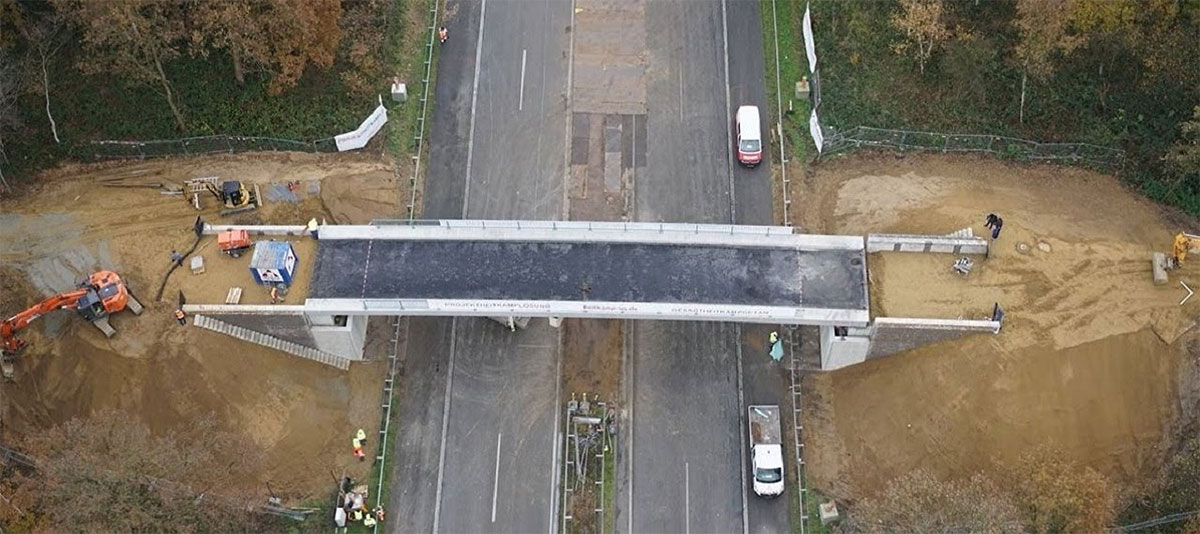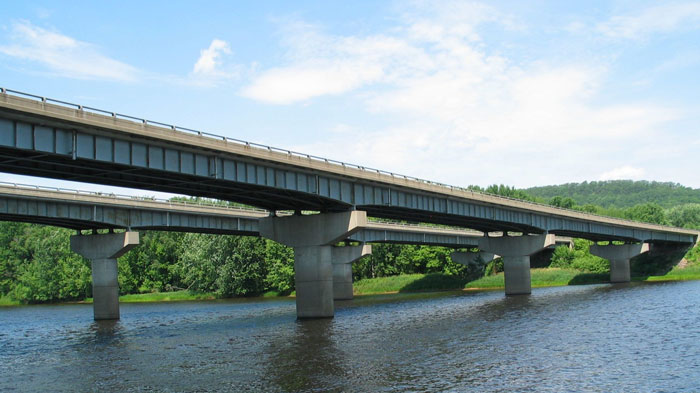
Bridge construction is a critical aspect of civil engineering, enabling the creation of essential transportation infrastructure. Bridges connect communities, facilitate the movement of people and goods, and play a vital role in economic development. In this article we discuss about building a bridge.
What are the main components of a bridge?
Bridges are complex structures that consist of several key components working together to provide support, stability, and safe passage. The main components of a bridge include:
- Superstructure: The superstructure is the upper portion of the bridge that carries the weight of the traffic and spans the gap or obstacle.
- Substructure: The substructure refers to the supporting elements of the bridge that transfer the loads from the superstructure to the foundation.
- Bearings: Bearings are devices that facilitate the movement and rotation of the superstructure on top of the substructure.
- Foundation: The foundation is the lowest part of the bridge structure that transfers the load from the bridge to the ground. It provides stability and prevents settlement or shifting.
- Decking and Surfacing: The bridge deck is the surface on which vehicles or pedestrians travel.
- Railing and Parapets: Railing and parapets are safety features installed along the sides of the bridge to prevent vehicles or pedestrians from falling off.
- Expansion Joints: Expansion joints are flexible elements placed at specific locations in the bridge to accommodate thermal expansion and contraction of the bridge components.
- Drainage System: Bridges incorporate drainage systems to manage water runoff and prevent water accumulation on the bridge deck.
The main types of bridges
The main types of bridges include:
- Beam Bridges: Beam bridges are the simplest and most common type of bridge. They consist of horizontal beams supported by vertical piers or abutments at each end. Beam bridges are suitable for short to moderate spans and are often made of reinforced concrete or steel.
- Arch Bridges: Arch bridges have a curved, arch-shaped superstructure that carries the weight of the bridge. The arch transfers the loads to the abutments or piers at the ends.
- Truss Bridges: Truss bridges have a framework of interconnected triangular elements (trusses) that provide strength and stability. The trusses distribute the loads to the piers or abutments.
- Suspension Bridges: Suspension bridges feature large main cables supported by towers or pylons at each end. The main cables are anchored into the ground and carry the weight of the bridge through vertical suspender cables.
- Cable-Stayed Bridges: Cable-stayed bridges are similar to suspension bridges but have shorter main cables that are directly connected to the bridge deck.
- Covered Bridges: Covered bridges have a traditional design with a roof and siding that encloses the bridge superstructure. They are often made of wood and were historically used to protect the bridge components from weathering.
Read more: Airport Runway Construction using geosynthetics
What are the steps in the bridge building process?
However, here are the general steps involved in the bridge building process:
- Planning and Design: The first step is to conduct a comprehensive planning and design phase. This involves determining the bridge’s purpose, location, span length, anticipated loads, and site conditions.
- Site Preparation: Once the design is finalized, the construction site needs to be prepared. This may involve clearing vegetation, excavating the ground, and establishing access roads and temporary construction facilities.
- Foundation Construction: The construction of the bridge foundation is a critical step. It involves excavating the foundation area and preparing the ground to support the bridge’s weight.
- Substructure Construction: After the foundation is in place, the substructure components are constructed. This includes building piers, abutments, and any other support structures that will carry the superstructure load.
- Superstructure Erection: Once the substructure is complete and cured, the superstructure components are erected. This involves assembling and installing the bridge’s girders, beams, or arches according to the design specifications.
- Deck Construction: The bridge deck, which serves as the roadway surface, is constructed on top of the superstructure. Depending on the bridge type, the deck may be made of reinforced concrete, steel, timber, or composite materials.
- Finishing and Detailing: After the deck is in place, finishing work is done to ensure the bridge’s functionality and aesthetics. This includes installing expansion joints to accommodate thermal movements, adding railing and parapets for safety, and incorporating drainage systems to manage water runoff.
- Testing and Inspection: Once the construction is complete, the bridge undergoes thorough testing and inspection to ensure structural integrity, load-bearing capacity, and adherence to safety standards.
- Opening and Maintenance: After successful testing and inspection, the bridge is ready for opening to the public. Regular maintenance and inspections are essential to ensure the long-term durability and safety of the bridge.
Different methods for bridge construction
Here are some common methods used in bridge construction:
- Cast-in-Place Concrete Construction: This method involves building the bridge on-site using concrete that is poured and cured in place.
- Precast Concrete Construction: Precast concrete construction involves manufacturing bridge components off-site in a controlled environment and then transporting and assembling them at the construction site.
- Steel Construction: Steel construction involves fabricating bridge components off-site and then transporting and assembling them on-site. Steel bridges are lightweight, durable, and can be built quickly.
- Suspension Construction: Suspension bridges are typically constructed using a combination of on-site and off-site methods. The towers or pylons are built on-site, while the main cables and suspender cables are usually fabricated off-site and then lifted into place.
- Cable-Stayed Construction: Cable-stayed bridges are constructed using a combination of on-site and off-site methods. The towers or pylons are typically built on-site, while the bridge deck and cable-stay system are often pre-assembled off-site.
- Incremental Launching: This method is commonly used for constructing long-span bridges, such as highway and railway bridges. The bridge is constructed in segments on temporary supports at one end of the bridge.
- Arch Erection: For arch bridges, the arch structure is often erected using temporary supports. The arch segments or precast arches are lifted and placed on these supports.
Read more: What Are The Rabitz Meshes
The equipment needed for the bridge construction process
Here are some common types of equipment used in bridge construction:
- Cranes: Cranes are essential for lifting and placing heavy components during bridge construction. Various types of cranes are used, including tower cranes, crawler cranes, and mobile cranes.
- Excavators: Excavators are used for earthmoving and excavation work, such as clearing the construction site, digging foundation pits, and shaping slopes.
- Pile Driving Equipment: Pile driving equipment is used for driving piles into the ground to create foundation support for the bridge. This equipment includes pile drivers, pile hammers, and vibratory hammers.
- Concrete Mixers and Batch Plants: Concrete mixers and batch plants are used to produce concrete on-site for various bridge components, including foundations, piers, abutments, and bridge decks.
- Formwork Systems: Formwork systems are used to shape and support freshly poured concrete until it hardens. This includes vertical formwork for constructing piers and abutments, as well as horizontal formwork for bridge decks.
- Scaffolding and Access Equipment: Scaffolding and access equipment are used to provide safe working platforms for construction workers to access different areas of the bridge during construction.
- Concrete Pumping Equipment: Concrete pumps are used to transport and place concrete in hard-to-reach areas or at height. They consist of a pumping system and a delivery pipeline, allowing concrete to be pumped directly to the desired location, such as bridge decks or elevated sections.
- Welding and Cutting Equipment: Welding and cutting equipment are necessary for joining and fabricating steel components during bridge construction.
- Surveying and Measurement Tools: Surveying and measurement instruments, such as total stations, laser levels, and GPS devices, are used to accurately measure and align bridge components during construction.
- Safety Equipment: Safety equipment is crucial for protecting workers during bridge construction. This includes personal protective equipment (PPE) such as hard hats, safety glasses, gloves, and high-visibility clothing.
Read more: Roof Sealing Using Geosynthetics
Bridge building using geosynthetics
Here are some common applications of geosynthetic products in bridge construction:
- Geotextiles: They are used in bridge construction for various purposes, including:
- Separation: Geotextiles are placed between different soil layers to prevent their mixing and maintain their individual characteristics. This helps to enhance the stability and load-bearing capacity of the bridge foundation and prevent the migration of fine particles.
- Filtration: Geotextiles act as filters by allowing water to pass through while retaining soil particles. They are often used in bridge abutments and retaining walls to prevent soil erosion and maintain the stability of the structures.
- Reinforcement: Geotextiles can be used as reinforcement in soil structures, such as embankments or retaining walls, to improve their strength and stability. They distribute the load more evenly, reduce settlement, and prevent the occurrence of localized failures.
- Geogrids: Some applications of geogrids in bridge construction include:
- Reinforced Earth Retaining Walls: Geogrids are often incorporated into reinforced earth retaining walls to provide tensile strength and prevent the movement of soil. They increase the stability and overall strength of the retaining wall system.
- Bridge Abutments and Approach Embankments: Geogrids can be used to reinforce the soil in bridge abutments and approach embankments. By confining the soil particles, they increase shear resistance, reduce settlement, and improve overall stability.
- Geocomposites: They are designed to provide multiple functionalities and are commonly used in bridge construction for the following purposes:
- Drainage: Geocomposite with a combination of geotextiles and drainage cores or geonets are used for efficient subsurface drainage systems beneath bridge structures. They help to control water accumulation, reduce hydrostatic pressure, and maintain the stability of the bridge foundation.
- Waterproofing: Geocomposites incorporating geotextiles and impermeable barriers, such as geomembranes, are used for waterproofing bridge decks and abutments. They prevent water infiltration into the bridge structure, protecting the underlying components from moisture damage.
Conclusion
In conclusion, bridge construction is a complex process that requires careful planning, engineering expertise, and the use of specialized equipment. Various construction methods, such as cast-in-place concrete, precast concrete, steel, suspension, cable-stayed, incremental launching, and arch erection, can be employed based on project requirements.






